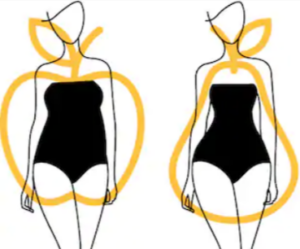
Cancer.gov
Researchers have revealed that the breast cancer risk in postmenopausal women is a function of waist circumference, independent of body mass index (BMI).
And that means that whether or not a woman’s body is in the shape of a pear or has an apple shape makes no difference.
This is because BMI is a numerical value that’s calculated from a person’s height and weight (though some calculations include age and gender).
But as you can see, these features of the calculation have nothing to do with the shape of a woman’s body.
A woman can have a pear shape and a BMI value equal to a woman with an apple shape.

Shutterstock/bus109
When I was a personal trainer I worked with women of all kinds of body shapes: pear, apple, buff, skinny-fat, “average,” you name it.
I found this study quite interesting because historically, studies have shown that the pear shaped person has a lower heart disease risk than the apple body.
The study about breast cancer comes from the American Cancer Society and focused on mostly white women.
The study was not able to verify previous findings that body shape alone is an independent risk for breast cancer.
The report points out that, indeed, many studies have linked abdominal excess weight or obesity to heart disease, type II diabetes and some cancers including breast.
The trend was to conclude that an apple shape (excess fat concentrated in a person’s middle) is more harmful than the pear shape (fat loaded more in the thighs, hips and butt).
Mia Gaudet, PhD, and her team analyzed data from almost 29,000 women.
A strong correlation was unveiled between postmenopausal breast cancer risk and waist size. But the association vanished once BMI was adjusted for.
Thus, regardless of being apple or pear shaped, a high BMI means a higher risk of breast cancer.
The study looked at BOTH the body mass index and waist circumference.
How to Shrink Waist Size

Freepik.com, prostooleh
Women who’d like to shrink their waist size to lower breast cancer risk need to step away from the crunch machine and pick up some heavy barbells.
Heavy barbell work will shear more fat off the entire body than will folding-movements that isolate a tiny muscle group.
How to Do It
Start with LIGHT weights first, and gradually increase over time. Safe heavy barbell work (e.g., deadlift, squat) means that you can do at least eight repetitions but it’s impossible to do more than 12.
Resting in between sets should be for a minute to two minutes, depending on the routine and how you feel, and you should not do jumping jacks or jogging in place in between sets. Rest fully so that you can give the next set your best effort.
Weight workouts fire up the body’s ability to burn fat by adding lean muscle.
As for aerobic exercise, this too, is important for reducing waist and belly size.
The most effective and time-saving way to make aerobics burn up belly fat is to employ interval training:
Do brief bouts of high exertion mixed with a few minutes of casual exertion. High intensity interval training can be applied to ANY mode of cardio exercise.
The full report is in Cancer Causes, and Control (April 2014).
 Lorra Garrick is a former personal trainer certified through the American Council on Exercise. At Bally Total Fitness she trained women and men of all ages for fat loss, muscle building, fitness and improved health.
Lorra Garrick is a former personal trainer certified through the American Council on Exercise. At Bally Total Fitness she trained women and men of all ages for fat loss, muscle building, fitness and improved health.
.











